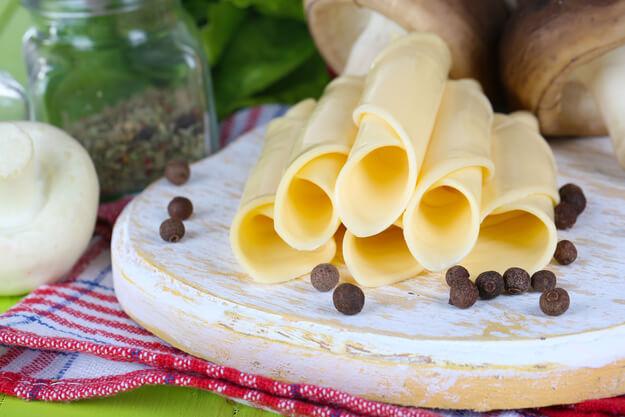483
Find out WHAT is in processed cheese
Cheese is a very frequent guest on our table. His story originates in the Swiss town of Thun shortly before the First world war. Local cheese-makers at that time produced so much cheese that it inevitably raised the question of its utilization. And so it appeared on the market a new dairy product.

It is hard to imagine the man who at least from time to time not enjoyed this tasty product. However, do we know about what is in processed cheese as it is produced and what impact it has on the body? Understand the question.

Processed cheese is a dairy product.
As a rule, in its composition, depending on the formulation includes the following ingredients:
natural fat and low-fat cheese;
— cottage cheese;
— powdered milk;
cream;
— butter;
— sour cream and other dairy products.
To achieve the desired consistency and taste in the manufacture of processed cheeses use salt-hot filling monoblocs: sodium citrate, sodium phosphates, potassium, calcium. However, the most effective are mixtures of different salts.
In addition to these ingredients, the composition of the processed cheese may include:
— starches;
— hydrocolloid (gum, carrageenan, pectin, gelatin, etc.);
— dyes;
— flavors;
— preservatives and antioxidants.
Also, to make processed cheeses with different tastes, recipes use sugar and different flavor additives: fruit, fish, meat, vegetables and others.
EXPERT COMMENTARYMoscow Andrey Vladimirovich,head of the expert division of Roskontrol
Phosphates are not harmful additives. However, if we recall that for natural dairy products characterized by an optimal ratio of calcium to phosphorus — 1 to 0,75, and phosphates in the technical regulations TR CU 029/2012 it is recommended to add in processed cheese in an amount up to 20 grams per kilogram, in the finished processed cheese with phosphates, we can already obtain a very different, very far from the optimal ratio of these two elements is 1 to 1.5. That is why the use of large quantities of these cheeses can lead to undesirable disturbance of the balance of calcium and phosphorus in the body.

In fact grilled cheese is the result of the disposal of various dairy products. In its production allowed the use of various dairy products including cheese and butter, with deviations from the established norms for the mass fraction of moisture, fat, salt, as well as in appearance, texture and taste.
However, the use of damaged and expired products in the manufacture of processed cheese is strictly prohibited. So, not allowed to recycle products with a rancid, rotten, putrid, pronounced salatim and musty taste and smell, with the smell of petroleum products, chemicals, as well as the presence of impurities.

Processed cheese — a product of long-term storage. This contributes to heat treatment during manufacture and the sealed packaging in which spreadable cheese without additives and preservatives can be stored for up to 180 days.
By the way,the presence of cheese preservatives and additives is not absolutely necessary to use them or not resolved exclusively by the manufacturer. Information about all used preservatives and additives must be indicated on the packaging.

Recently, the "cheese-like" products found on store shelves is much easier than traditional processed cheeses. This is due primarily to the fact that during the crisis, many producers were forced to reduce the cost of production due to the use of cheaper vegetable oils, cheese and dry components. In particular, many businesses have reduced in your recipe the amount of milk fat, partially or completely replacing it with vegetable.published
P. S. And remember, only by changing their consumption — together we change the world! ©
Join us in Facebook , Vkontakte, Odnoklassniki
Source: oppps.ru/nyuansy-plavlennogo-syra.html

It is hard to imagine the man who at least from time to time not enjoyed this tasty product. However, do we know about what is in processed cheese as it is produced and what impact it has on the body? Understand the question.

Processed cheese is a dairy product.
As a rule, in its composition, depending on the formulation includes the following ingredients:
natural fat and low-fat cheese;
— cottage cheese;
— powdered milk;
cream;
— butter;
— sour cream and other dairy products.
To achieve the desired consistency and taste in the manufacture of processed cheeses use salt-hot filling monoblocs: sodium citrate, sodium phosphates, potassium, calcium. However, the most effective are mixtures of different salts.
In addition to these ingredients, the composition of the processed cheese may include:
— starches;
— hydrocolloid (gum, carrageenan, pectin, gelatin, etc.);
— dyes;
— flavors;
— preservatives and antioxidants.
Also, to make processed cheeses with different tastes, recipes use sugar and different flavor additives: fruit, fish, meat, vegetables and others.
EXPERT COMMENTARYMoscow Andrey Vladimirovich,head of the expert division of Roskontrol
Phosphates are not harmful additives. However, if we recall that for natural dairy products characterized by an optimal ratio of calcium to phosphorus — 1 to 0,75, and phosphates in the technical regulations TR CU 029/2012 it is recommended to add in processed cheese in an amount up to 20 grams per kilogram, in the finished processed cheese with phosphates, we can already obtain a very different, very far from the optimal ratio of these two elements is 1 to 1.5. That is why the use of large quantities of these cheeses can lead to undesirable disturbance of the balance of calcium and phosphorus in the body.

In fact grilled cheese is the result of the disposal of various dairy products. In its production allowed the use of various dairy products including cheese and butter, with deviations from the established norms for the mass fraction of moisture, fat, salt, as well as in appearance, texture and taste.
However, the use of damaged and expired products in the manufacture of processed cheese is strictly prohibited. So, not allowed to recycle products with a rancid, rotten, putrid, pronounced salatim and musty taste and smell, with the smell of petroleum products, chemicals, as well as the presence of impurities.

Processed cheese — a product of long-term storage. This contributes to heat treatment during manufacture and the sealed packaging in which spreadable cheese without additives and preservatives can be stored for up to 180 days.
By the way,the presence of cheese preservatives and additives is not absolutely necessary to use them or not resolved exclusively by the manufacturer. Information about all used preservatives and additives must be indicated on the packaging.

Recently, the "cheese-like" products found on store shelves is much easier than traditional processed cheeses. This is due primarily to the fact that during the crisis, many producers were forced to reduce the cost of production due to the use of cheaper vegetable oils, cheese and dry components. In particular, many businesses have reduced in your recipe the amount of milk fat, partially or completely replacing it with vegetable.published
P. S. And remember, only by changing their consumption — together we change the world! ©
Join us in Facebook , Vkontakte, Odnoklassniki
Source: oppps.ru/nyuansy-plavlennogo-syra.html
A harvest of delights — the secrets of growing onions
What is the energy storage with energy-intensive























